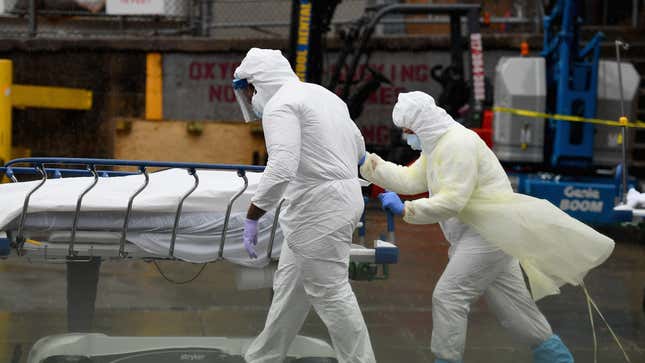
It will take a long time to truly know the toll of deaths and injuries caused by the ongoing covid-19 pandemic. But a new study out Wednesday provides an early estimate of the excess deaths linked to the viral disease in the United States. It suggests that the country’s official count may have missed up to 27,000 deaths as of late May.
Counting excess deaths—defined as deaths above the baseline seen in previous years during the same time period—from all causes is often considered a more accurate way to measure the fatal impact of a newly emerged and widespread disease, since the official toll can miss people who weren’t diagnosed before they died. Initially, doctors and scientists can have trouble identifying or confirming deaths caused by a new disease, either due to a lack of familiarity with its symptoms, no available tests to confirm a diagnosis, or simply because the disease wasn’t known to exist in that area at the time.
Scientists did quickly create a relatively accurate test for the coronavirus that causes covid-19 after its discovery in China late last year. But the U.S. federal government’s delayed and flawed response left states without testing readily available for months once the pandemic started to pick up steam in March. The lack of testing also hindered attempts to recognize and contain the earliest outbreaks in states like New York and Washington, which further enabled its spread. It’s now thought that the virus was circulating locally in the U.S. as early as January.
In this new study, published in JAMA Internal Medicine, researchers tried to calculate excess deaths across the country from March 1 to May 30.
Between those months, 95,235 deaths were officially attributed to covid-19 in most of the U.S. But the authors calculated, based on comparing deaths this year to other recent years, that there were likely 122,300 excess deaths during that time, about 28% higher than the official count of covid-19 deaths. That leaves about 27,000 deaths above the normal March-May baseline in the U.S. that were not otherwise attributed to covid-19, which suggests the virus has killed many more people than the official count says.
“The number of reported covid-19 deaths likely represents an undercount of the true burden caused by the virus,” lead author Daniel Weinburger, an infectious disease epidemiologist at Yale University, told Gizmodo via email. “There have been questions about whether the reported statistics overcount covid-19 deaths. Our analyses suggest the opposite.”
There are limitations to these findings, though. For one, there wasn’t available death data from the states of Connecticut and North Carolina at the time, so they weren’t included in either the count of covid-19 or excess deaths. As of early July 1, Connecticut and North Carolina have reported 4,322 and 1,343 covid-19 deaths, respectively.
Another caveat is that the authors made several adjustments and assumptions for their estimates, including trying to account for delays in states reporting deaths. Many states, especially early on in the pandemic, have had backlogs of tests, meaning that someone who was tested for covid-19 and died from it in March may have gone unconfirmed for months. States are still occasionally adding large numbers of new deaths that occurred earlier than reported. However, Weinburger said that their assumptions should make their model more accurate than other attempts to measure the number of excess deaths during the pandemic.
“Some news outlets have generated estimates of excess deaths by simply comparing the number of deaths in each week to the average number of deaths in that week in previous years,” he said. “This ignores trends over time (e.g. increases or decreases due to changing population sizes). It also does not adjust for reporting delays, so they are not able to provide estimates for more recent weeks.”
Perhaps the most important consideration is that not all of these excess deaths were necessarily caused by covid-19 directly. Some excess deaths may reflect deaths of people with chronic conditions that weren’t treated because of the strains on some hospitals or because they were fearful of getting care at the time due to the pandemic. But the team’s data and other research doesn’t support the theory voiced by many skeptics of the lockdowns that the actions created to slow the pandemic caused lots of preventable deaths, and certainly not more deaths than those caused by the pandemic itself during that time.
“There have certainly been increases in deaths due to heart attacks, strokes, Alzheimer’s, and some of these could be linked to avoiding emergency healthcare,” Weinburger said. “I think the increases related to lockdown measures are small compared to the increases caused directly by covid-19. A number of states that implemented lockdown measures but had small epidemics of covid-19 in March-May had little excess death.”
Untangling how deadly covid-19 has been and will be is something that will take a long time. But it’s likely that we’ve been getting better at it as time has gone on, since tests have become more available. So we might not see such a wide gap between excess and covid-19 deaths going forward, provided testing remains available. But there may still be differences between states, depending on their guidelines for declaring a death to be due to covid-19 (some but not all states now publicly share data on probable covid-19 deaths).
Even now, this study highlights just how much suffering has been caused by covid-19, and how much of its destruction early on we may have missed. Weinburger and his team, for their part, hope that their research and model will continue to provide a key tool in measuring the true toll of the pandemic.
As of July 1, the U.S. has reported around 127,000 coronavirus deaths, according to Johns Hopkins University’s tracker.